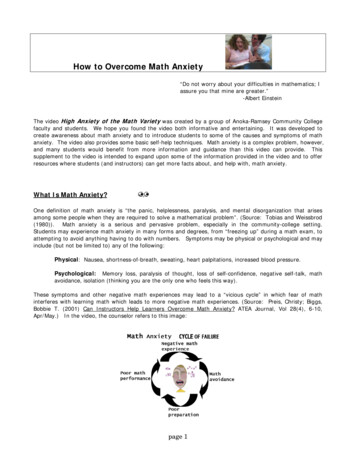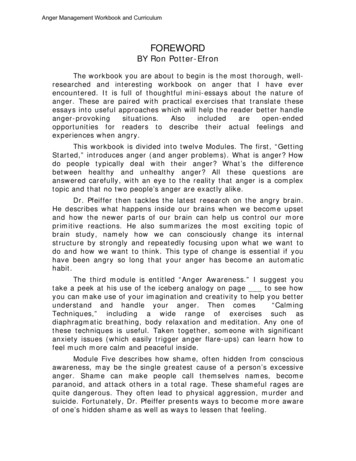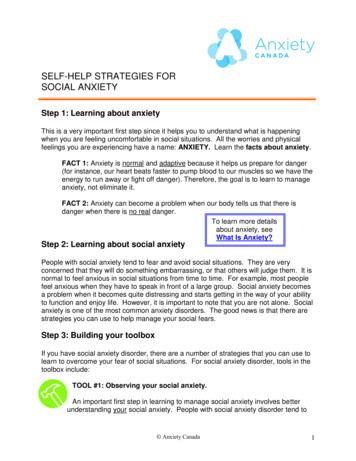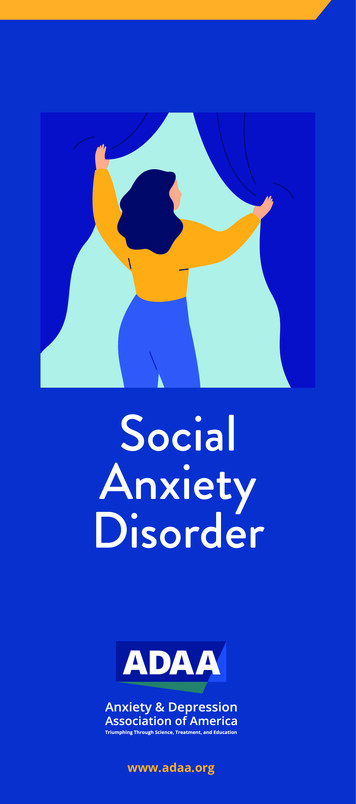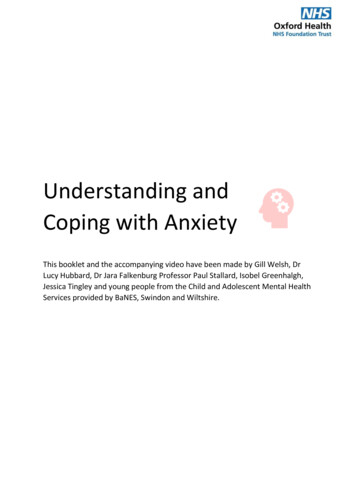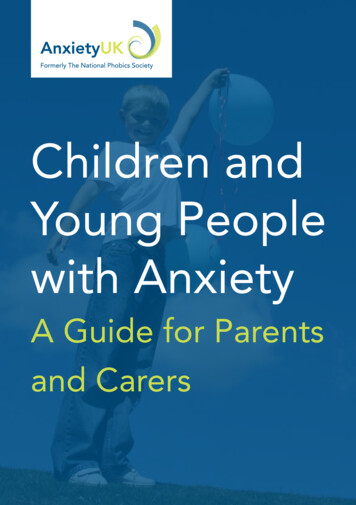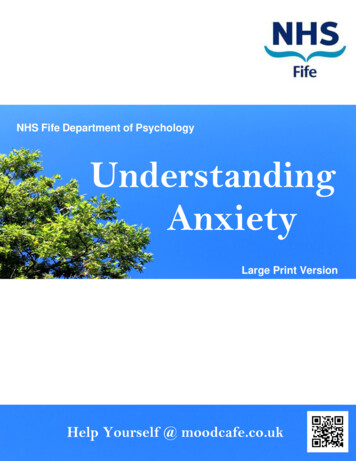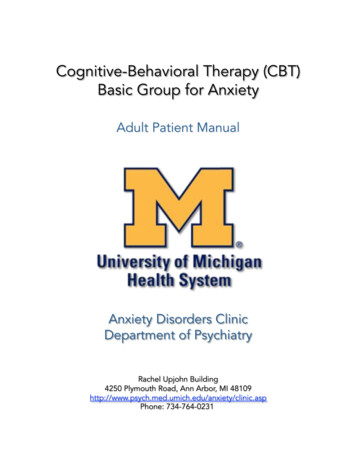
Transcription
AcknowledgementsWritten by Dan DeSena, LMSW, DMAEditors:Pam Schweitzer, APRN, BCLaura Lokers, LCSWRicks Warren, PhDBased in part on the knowledge and expertise of:James Abelson, MD, PhDJoseph Himle, PhDLaura Lokers, LCSWPam Schweitzer, APRN, BCRicks Warren, PhDi.
Depression ProgramCBT Basic Group forDepressionCBTBehavioralActivationGroup forDepressionCBTCognitiveSkills GroupforDepressionMindfulness-Based Cognitive Therapyfor depression relapse preventionAnxiety ProgramCBT Basic Group forAnxiety(2 sections)CBTCognitiveSkills Groupfor AnxietyCBTExposureGroup forAnxietyMindfulnessfor AnxietyGroupii.
What is this group all about?-Our group is an introduction to the basic concepts andskills of CBT.-There are four sessions, each with a different topic.-These are offered weekly, the first four Mondays andTuesdays of every month. Each Monday and Tuesday isthe same topic, so you can come to whichever fits yourschedule best.-You can attend these in any order you like.-Each session we will cover just some of these CBTskills. If you have questions during the group, please ask!It is also possible any confusion you have at thebeginning will clear up as you continue to attendthe sessions.-This group is not meant to fix your anxiety completely.We want to give you a chance to try out some of thesetechniques and understand your anxiety better. When youget done with this group you may want to continue withgroup or individual CBT treatment here at U of M.What is Cognitive-Behavioral Therapy?Cognitive-Behavioral Therapy (CBT) is a short-term,evidence-based treatment for many problems, includinganxiety. It is based on the idea that thoughts (cognitions)and behaviors affect the way we feel.Weekly Group topics:Anxiety Vulnerability Management (week 1)Do you ever think you have more anxiety thanother people? Find out why and learn how to useCBT skills to fight your anxiety over the long term.Relaxation (week 2)Just relax! What to do and when to try relaxationstrategies to help make you feel less stress andtension in your daily life.Exposure and Desensitization (week 3)“Avoid avoidance:” how our behaviors can makeanxiety worse, and the surprising way to get it toleave us alone!Cognitive Therapy Skills (week 4)Our thoughts matter! Learn ways our thoughts canchange how we feel and influence what we do.Turn thoughts into your ally, instead of your enemy.We want to be sure that our treatment iseffective!Evidence-based means that there is scientificevidence to show that something works.CBT is an evidence-based treatment that has beenstudied and shown to be effective in hundreds ofscientific experiments.Feelings (emotions)While there is no 100% guarantee that CBT willwork for you, it is likely that with practice and hardwork you will receive benefit from thesetechniques.Thoughts (cognitions)Behaviors (actions)How to use this manualThis manual includes a lot of information on anxiety and CBT– more than we have time to cover in the group sessions, and perhaps more than youwill have time to review on your own! You will get the most out of this group if you take notes during the group and then review the manualbetween sessions. Remember that different people get benefit from different CBT skills, so we expect that you will use the skills that work and letgo of the rest. We hope that you will try each skill out to determine if it suits you. Refer to “Appendix IV: This is so much information! Wheredo I start?” to make your reading more efficient by starting with the information most pertinent to your particular problem. Finally, be sure tobring the manual back next week!iii.
There is a great deal of scientific research onpsychotherapy, and we know a lot about whatcan be helpful for people. We continue tolearn more and more about how to usepsychotherapy to help as many people aspossible.However, because everyone is different, andour brains and lives are very complex, rightnow it is often hard to know exactly what it isthat will help a particular person feel better.On the next page, follow thepath from the bottom of thepage upward for some tips tomake your “path throughpsychotherapy” more helpfuland rewarding.iv.
See this as just one piece of the puzzle in your process of better understandingyourself and moving toward what you want in your life. Get all you can out of itand then make efforts to find out what other types of work could be helpful. Forexample, maybe you did a great deal of work on managing your depression withcognitive and behavioral skills. Now you believe that you want to improve yourrelationships to achieve more in that area of your life.Manage barriers to showing up regularly to treatment and practicing skills: improvementdepends primarily on follow-through and the amount of work you put into your therapy.Address depression from different angles. There is no one “silver bullet” that willchange depression all by itself. Usually a combination treatment, or mixedapproach is what works best to make depression better. This also means putting insome effort to understand the different ways to manage your depression.Practice skills over, and over, and over. It usually takes time for changes in ourbehavior and thinking to lead to feeling better. Like learning an instrument, weare practicing new ways of doing things that will feel “clunky” at first, andbecome more comfortable over time.Take small steps toward change each day. Try not to wait for “light bulbmoments,” “epiphanies,” or for something to take it all away instantly.Expect ups and downs during the process. Think of it as “2 stepsforward, 1 step back.” Try not to get too discouraged or give upwhen things seem to move backward or stagnate.Make it about you: engage in your treatment because you want to improve your life,take responsibility for achieving you aims, and feeling better, not because others aretelling you to do so. Remember that even if you are being pushed to engage in therapyby someone else, that relationship must be important enough for you to consider thisoption!Maintain an open mind about the possibility of change, while being realistic abouthow fast this change can happen.Especially at first, gauge success according to how you change your responses to stress,uncomfortable emotions, and body sensations, not whether or not these things exist orcontinue to occur. Focus on valued action, even more than just “feeling better.”“Credibility:” Make sure the treatment in which you are engaging makes sense toyou and seems to be addressing your problem. There are different paths to thesame goal. If this type of therapy is not working for you, you are confused aboutwhat you are doing, or you have any other concerns, talk to your clinician rightaway. Clinicians are trained to have these discussions with their patients!Make sure your definition of the “problem” is the same as the clinicians withwhom you are working. Maybe they think it is “depression” and you think it issomething else. Try to clarify this with your clinicians.v.
Section One: Anxiety 101 . .1.1Anxiety Is 1.2Why does my body do this? 1.3Anxiety “Triggers” . . 1.4Anxiety “Fuel” . . 1.6Anxiety 101 Summary . 1.9Section Two: Exposure and Desensitization . . 2.1What is exposure? . 2.2Should I do exposure? . . 2.3Desensitization .2.4Exposure: Getting Started .2.6The Exposure Formula . . . 2.8Exposure Tips . . . 2.9Exposure: Tracking Your Progress5 . . . 2.10Exposure examples: “External Cue Exposure” . . . 2.11Exposure Examples: “Internal Cue Exposure” for Panic Disorder . . 2.12Questions about Exposure . . . . 2.14Exposure for Obsessive-Compulsive Disorder . . . . . 2.15Barriers in Exposure Treatment . . . . . 2.16The Freedom of Choice: Exposure in Daily Life . . . . . .2.17Exposure and Desensitization Summary . . . . . . 2.18Fear Hierarchy Homework Form (blank) . . . . . . . 2.19Exposure Tracking Form (blank) . . . . .2.20Exposure Tracking Form for Hourly Exposure (blank) . . . . .2.21Section Three: Cognitive Therapy Skills . . . . . . 3.1What are Cognitive Therapy Skills? . . . . . . . 3.2Negative Automatic Thoughts . . . . . . . 3.4Identifying Negative Automatic Thoughts . . . . . . 3.6Thought Cascade Worksheet . . . . . . . 3.7Daily Thought Record Worksheet . . . . . . 3.8Cognitive Distortions . . . . . . .3.9Examples of Cognitive Distortions . . . . . . 3.10Examining the Evidence . . . . . . 3.12The Gambler: Predicting Ourselves Anxious . . . . . . . 3.13Catastrophizing: “That Would Be Horrible” . . . . . . 3.14Examining Thoughts, Written Method . . . . . . . . 3.16Examining Thoughts Worksheet . . . . . . . 3.17“The Only Thing We Have to Fear is Fear Itself:” How to work onnegative thoughts about anxiety and panic attacks . . . . . 3.18“Don’t worry ”Cognitive Skills for Daily Worry and Generalized Anxiety. . . 3.24Common Thoughts about Anxiety and its Treatment . . . 3.30Cognitive Therapy Skills Summary . . . . . . . . 3.31
Table of Contents, con
“We experience moments absolutely free from worry. These brief respites are called panic.” Cullen HightowerThis part of the group is meant to explore important information about the anxiety itself. Thefirst step to managing anxiety is understanding it as well as we can– to “know thine enemy,”so to speak.On the pages entitled “Anxiety is ” and “Why does my body dothis?” we’ll talk about:-What the anxiety “alarm” really is: the “fight or flight”response— and what its common symptoms are-The difference between normal anxiety and “phobic”anxiety-What causes anxiety-Why our bodies do what they do when we are anxious-Why we can’t just “get rid of” the anxietyIn the section “Anxiety Triggers,” we’ll go over the differentthings that can trigger anxiety and how the brain comes to believethese triggers are dangerous.In our final section, “Anxiety Fuel,” we learn about common waysthat anxiety can get worse, and how our own thoughts and behaviorsplay a role in this process.1.1
Anxiety Is Anxiety is a part of our bodies’ natural alarm system, the “fight or flight” response, which exists to protect usfrom danger. These natural body responses are not harmful— but they are really uncomfortable!The most pure form of the “fight or flight” response is a panic attack, which involves a rush of anxiety symptoms, many of which arelisted below, usually peaking in about 10 minutes. In these cases, the body is trying to tell us “something dangerous is happening rightnow!” Other forms of anxiety that are less acute but often just as debilitating, such as chronic worry, involve symptoms similar to the“fight or flight” symptoms of panic attacks. However, in these cases, it is as if the body is saying “something dangerous is going tohappen sometime in the future so watch out!” The differences between the two are the intensity of the response and the context inwhich it is triggered. In this manual we will refer to all anxiety symptoms as being related to the “fight or flight” response. The mostcommon anxiety symptoms are listed below. Try circling the ones that apply to you.Physical SymptomsCognitive (thinking) Symptoms-Rapid heartbeat-Sweating-Trouble breathing-Tightness in the chest, chest pain-Dizziness-Feeling: “Things aren’t real”-Feeling: “I don’t feel like myself.”-Tingling and numbness in fingers, toes,and other extremities-Nausea, vomiting-Muscle tension-Low energy, exhaustion-Changes in body temperature-Shaking, jitters-Urgency to urinate or defecate-Changes in vision and other senses-Worries-Negative thoughts about one’s ability totolerate emotions or future stress-Negative predictions about futureevents-Other common thoughts:“I am going crazy!”“I am going to have a heart attack!”“I am going to faint.”-Trouble concentrating or keepingattention-Magical ideas, phrases or images suchas “If I do not wash my hands I willdie or someone will be harmed.”-Preoccupation with body sensations orfunctionsBehavioral Symptoms-Avoidance of anything that provokesanxiety, including people, places,situations, objects, animals,thoughts, memories, bodyfeelings, etc.-Protective, “safety” behaviors-Aggression, verbal abuse, lashing out-Alcohol and/or drug use-Compulsive behaviors, such asexcessive checking or otherunreasonable or harmful rituals orroutinesWhat causes anxiety?We know from scientific research that anxiety is caused by a combination of factors related to both “nature” (genetics) and“nurture” (experience). Check out page 82 for a more detailed explanation of the factors that can lead to anxiety.When “fight or flight” goes too far: “Phobic” anxietyEveryone experiences anxiety from time-to-time. We often get the question: “How do Iknow if I have an anxiety disorder?” An anxiety disorder is diagnosed when someoneexperiences anxiety symptoms and these symptoms:-Interfere with a person’s life aims-Happen too often or with too much intensity, given the actualdanger of a situation-Are not explained by other factors, such as a medical problem orsubstance abuseSome people experience significant anxiety and choose simply to live with it. It is up toyou to decide if you can handle the anxiety on your own, or if treatment is necessary.Take home point:The symptoms of anxiety are the “fight or flight” response, and are normal, functional, andnecessary for survival. They become a problem when they are too severe or happen too often, giventhe real amount of danger present, or if it interferes with the activities of life.Why can’t I just get ridof my anxiety?Anxiety is as vital to oursurvival as hunger and thirst.Without our “fight or flight”response we would not be asaware of possible threats to oursafety. We also might not takecare of ourselves or prepareadequately for the future. Andwe probably wouldn’t enjoy ascary movie or a roller coaster!Anxiety is necessary to protectus and can even be fun at times.It isn’t in our best interests toget rid of it completely!Remember: Anxiety is uncomfortable, not dangerous!1.2
There is a reason!We have evolved over millions of years to better protect ourselves. Our brains have learned to automatically signal danger when it ispresent or we perceive that we may be harmed in some way. Each symptom of anxiety has a specific evolutionary purpose, to help us“fight” or “flee.”Try to figure out how each symptom of anxiety is used by our bodies to protect us when we are in danger, by matching theevolutionary purpose with the anxiety symptoms. Some in the right-hand column may be used twice, and there may be multipleanswers for some symptoms. Once you are done, you can see if you were right— the answers are at the bottom of the page. Also, amore detailed diagram of the biology of the “fight or flight” response is in Appendix I, “The Biology of Fight or Flight.”Anxiety Symptom1. Rapid heartbeatPurposeA. Muscles contract and tighten to help us fight or flee2. Sweating3. Flushing in face4. Tightness in the chest, chest painB. Push blood around the body faster to supply cells withoxygen in case we need to use energy to flee or protectourselvesC. Lots of energy is spent for body to protect us5. Feeling: “Things aren’t real”6. Feeling: “I’m not myself”7. Tingling or numbness infingers and toes8. Nausea, vomitingD. Body increases speed and depth of breathingE. Thoughts tend to be negative and protective; it is dangerousto have “good” thoughts if we are in danger!F. Must stay alive, even if it means using force9. Muscle tension, stiffness10. Low energy, exhaustion11. Changes in body temperature12. Shaking, jitteriness13. Urgency to urinate or defecateG. Try to think of ways to protect ourselves in case bad thingshappen in futureH. Brain is constantly scanning for danger, from one thing tonextI. Body stops digestion and attempts to rid itself of excessiveharmful substances14. Hyperventilation or trouble breathing15. Dizziness, lightheadedness16. Worries17. Negative predictions about future events18. Trouble concentrating or keeping attentionJ. If something is dangerous, remember it and get away from it!K. Cools us off when we are running or fighting and makes itharder for a predator to grab usL. Blood is redirected away from head, skin, fingers, and toes; ifwe are cut, we will not bleed to death as easily19. Avoiding20. Fight or be aggressiveM. Decrease in salivation21. Changes in vision, hearing, smell, taste22. Dry mouthDid you know when our body’s “fight or flight” alarm is triggered, a domino effect of chemical changes and messages are sent tovarious parts of the brain and body, producing these symptoms. This process is programmed to last only about 10 minutes, unless it istriggered again.Answers: 1. B 2. K 3. B 4. A,D 5. L 6. L 7. L 8. I 9. A 10. C 11. L 12. A 13. I 14. D 15. L 16. E 17. G 18. H 19. J 20. F 21. L 22. M1.3
Our brains are designed to keep us safe. The anxietypart of the brain, the amygdala, is like a radar that istrained to spot dangerous objects and situations.When this “radar” spots something that could bedangerous, it tells the brain to begin the “fight orflight” response, producing the uncomfortablefeelings we get when we are anxious.“One thing leads to another:” how a trigger becomes connected with our “fight or flight” responseWhen we perceive danger, whatever it is that could be dangerous (in this case, a spider) is remembered by the amygdala. The nexttime something reminds us of the spider, or we actually come into contact with one, our anxiety “alarm” goes off.!!! “danger” or something bad happening(for example, getting bitten by the spider)Now and infuture Types of anxiety triggers and the Anxiety Disorder “Diagnosis”Nearly anything can be trained to trigger the “fight or flight” response. Psychiatrists, psychologists, psychiatric nurses, and clinicalpsychiatric social workers have tried to find ways to tell the difference between different types of anxiety triggers. Anxiety disorderdiagnoses come out of this attempt. While a diagnosis is not a perfect way of describing a person’s experiences, it can help us toknow what types of treatments may be effective. Different groups of triggers and the diagnoses most frequently associated with themare listed below. Some of these categories overlap, and it is possible for one person to have more than one diagnosis.TriggerDiagnosisWorries, predictions, and negative thoughts about the futureGeneralized Anxiety Disorder (GAD)Social situations and people, such as social events and performances, alongwith fear of criticism from othersSocial Anxiety Disorder (Social Phobia)Fear of having a panic attack and fear of body feelings that remind one ofpanic attacksPanic DisorderPlaces a panic attack has happened before or could happenAgoraphobiaPlaces, situations, animals, objects, blood or injury, etc.Specific PhobiasDisturbing intrusive thoughts, contamination, doubt and urge to check things,etc.Obsessive-Compulsive Disorder (OCD)Memories and things associated with a traumatic eventPost-Traumatic Stress Disorder (PTSD)1.4
Anxiety “Triggers,” continued“Which came first, the chicken or the egg?”Scary event?Anxiety?Some people wonder if scary events caused their anxiety, or if their anxiety itself is what causes them to more readily see things asscary.We know from scientific research on anxiety that both are true. Events and stress in our lives cancreate more anxiety. For example, a passenger on a flight that barely escapes an serious accidentmay feel anxiety the next time they take a flight, especially if this was one of their first flyingexperiences. Flying may then become a new anxiety trigger. Conversely, someone that is alreadyvulnerable to having anxiety (see page 82 for more on this) may experience normal turbulence on aflight as scary and then feel afraid to fly in the future.What if I don’t know what triggers my anxiety?For the sake of treatment, it is important to learn to identify what it is that makes you anxious. For some people it is very clear; forothers, anxiety seems to come from “out of nowhere.”To identify what makes you anxious, ask yourself the following questions:“When I feel scared or nervous, what is going on around me or what am I thinking about?”“Am I worried about having more anxiety in the future?”“Am I afraid of body sensations that remind me of intense anxiety attacks?”“Do I ever try to do more than I can handle or create unrealistic expectations for myself or others?”“Am I worried that I will not be able to cope if bad things happen in the future?”Anxiety “Triggers” take home points:The brain can learn to be afraid ofalmost anything, and some anxiety“triggers” are more common thanothers. These triggers help defineanxiety disorder diagnoses, which weuse to better understand the anxietyand develop treatments.Anxiety can be caused by scary events,and anxiety can also make one morelikely to experience an event as scary.It is important to understand youranxiety “triggers.” In most cases it ispossible to figure them out yourself.Sometimes it is necessary to have thehelp of a mental health professional todo so.ExerciseMy anxiety triggers are:List here the objects, situations, events, or places that tend to trigger your anxiety. Usethe questions above if you are having trouble figuring out what makes you anxious.1.2.3.4.5.6.7.1.5
When we feel anxious, we typically want to do something to make ourselves feel better. Most of thesebehaviors feel natural because our bodies also want to keep us safe. However, some of these behaviorscan make things worse; we add “fuel” to the anxiety “fire.” We can add fuel gradually over time ordump lots on all at once. In all cases the anxiety “fire” gets bigger.What behaviors are in danger of causing the anxiety to get worse? Anything that teaches the amygdala (the anxiety center ofthe brain) that something is dangerous. Remember our spider example? Let’s say that every time this man sees a spider he triesto avoid it by getting away. What does this teach him? That the spider is dangerous, of course!“Danger!!” Each time he avoids the spider, his amygdala gets more feedback that the spider is dangerous. Next time he sees the spider, hisanxiety “alarm” will be louder, or it may go off more quickly than before. The process by which the brain learns that somethingis more dangerous over time is called sensitization. It is also called reinforcement of the anxiety because the anxiety responsegets stronger and stronger. Reinforcement can happen both in the short term (when the danger seems to be present) or in thelong term, as we discuss below.Short-term reinforcement: the anxiety “snowball effect”Have you ever worried about speaking in front of a group of people? Worries about performing well can lead to jitteriness,cracking voice, difficulty concentrating, and other “fight or flight” symptoms. Often the physical anxiety symptoms will thencreate more worry about the performance; this creates a “snowball effect,” in which anxiety gets worse and worse, even to thepoint of panic.Worry about speech“Fight or flight” symptoms during speech“People may see that I am nervous!”(more worry)1.6
Anxiety “Fuel,” continuedLong-term reinforcement: “Safety Behaviors” and negative thoughts/beliefsAs mentioned earlier, anxiety “fuel” is anything that teaches the anxiety center of the brain, the amygdala, thatsomething is dangerous. Over the long term, the most common ways to do this involve negative thoughts and beliefsas well as protective actions called safety behaviors. While these behaviors seem to help the anxiety right now, theyusually make it worse in the long run. Examples are listed below.BehaviorsSafety behaviors are often justified using “as long as” statements:Avoidance: “As long as I avoid that, I will be safe.”Attacking others, acting on anger, etc.: “As long as I use verbalor physical force to protect myself, I will have control.”Protective behaviors: “As long as I have my water bottle withme, I am safe and will not have another panic attack.”Rituals (usually part of OCD, characterized by excessive,repetitive checking, washing, counting, asking for reassurance,etc.): “As long as I knock four times when I have a scary thought,nothing bad will happen to my daughter.”Substance use (trying to “numb” the anxiety): “As long as I canhave some alcohol, I will feel better.”ThoughtsNegative thoughts about:-the future-yourself-other people-the worldExamples:“I am going to lose my job and end uphomeless.”“I must have control ”“That person thinks I am an idiot.”“If I drive on the highway I will get into anaccident.”“If I keep having this thought it must betrue.”Whether in the short run or over time, anxiety feelings, fearful thoughts, and protective, “safety” behaviors worktogether to keep our anxiety “fire” burning. Each feeds off the others, and any one of these can act as the “match” toget the fire started. In CBT, our goal is to work on these thoughts and behaviors to help extinguish the fire asmuch as possible.Anxiety symptoms (“fight or flight” response)Fearful thoughtsSafety behaviors1.7
Anxiety “Fuel,” continuedAnxiety “Fuel” take home points:Some of our thoughts and behaviors, while they seem to help us, actually make anxiety worse. Safety behaviors, such asavoidance and protective behaviors, as well as negative thoughts, serve to reinforce anxiety in both the short- and long-term.It is important to understand what, if any, safety behaviors we are using, so that we can work to reverse this through treatment.ExerciseAnxiety “Fuel”Below, list some of the ways you may accidentally make your anxiety worse, based on the material discussed above.AvoidanceAnger and IrritabilityProtective “Safety” BehaviorsDo I avoid anything because it seems scaryor makes me feel anxious? This mayinclude avoiding thinking about somethingor avoiding certain types of situations orpeople.Do I become angry or irritable andattack others verbally or physically?Do I try to protect myself in certainsituations in order to feel more safe?Times I become angry:How I try to protect myself:1.1.2.2.3.3.4.4.What I do when I am angry:5.1.6.2.7.3.8.Things I avoid:1.2.3.4.5.6.7.4.Substance UseThoughtsDo I ever use drugs or alcohol in order to “numb” theanxiety?Do I have thoughts that come up continually and make me feelanxious?Types of drugs or alcohol:Thoughts that make me feel anxious:1.2.When I tend to drink or use drugs:3.4.5.6.1.8
Anxiety Is Why does my body do this?We learned that the symptoms of anxiety are the“fight or flight” response, and are normal,functional, and necessary for survival. Theybecome a problem when they are too severe orhappen too much given the real amount ofdanger present, or if it interferes with theactivities of life. While having chronic anxietyover long periods of time puts stress on thebody, it can be helpful to remember that anxietyitself is not dangerous; but it sure can beuncomfortable.In this section we covered the ways that each“fight or flight” symptom functions to protectus in case we are in real danger.Anxiety TriggersAnxiety FuelHere we learned that the brain can learn to be afraidof almost anything, and some anxiety “triggers” aremore common than others. Anxiety disorderdiagnoses are organized based on what triggers theanxiety.Some of our thoughts and behaviors, while theyseem to help us, actually make anxiety worse.Safety behaviors, such as avoidance andprotective behaviors, as well as negativethoughts, serve to reinforce anxiety in both theshort- and long-term.We know that anxiety can be caused by scary events,and anxiety can also make one more likely toexperience an event as scary.It is important to identify your anxiety “triggers.” Inmost cases it is possible to figure them out yourself.Sometimes it is necessary to have the help of amental health professional to do this. A few tips areon page 10.We also learned that when our body’s “fight orflight” alarm is triggered, a domino effect ofchemical changes and messages are sent tovarious parts of the brain and body, producingthese symptoms. This process is programmedto last only about 10 minutes, unless it istriggered again.It is important to understand how we make ouranxiety worse, so that we can work to reverse thisthrough treatment.A common question: What if it really is da
In the section “Anxiety Triggers,” we’ll go over the different things that can trigger anxiety and how the brain comes to believe these triggers are dangerous. In our final section, “Anxiety Fuel,” we learn about common ways that anxiety can get worse, and how our ow
